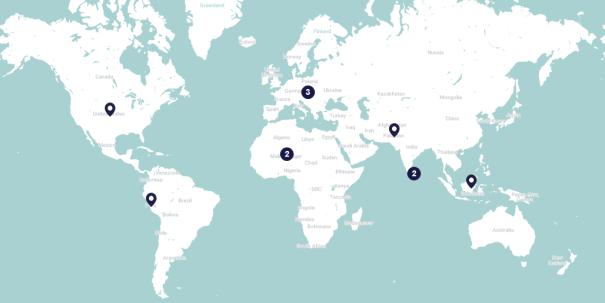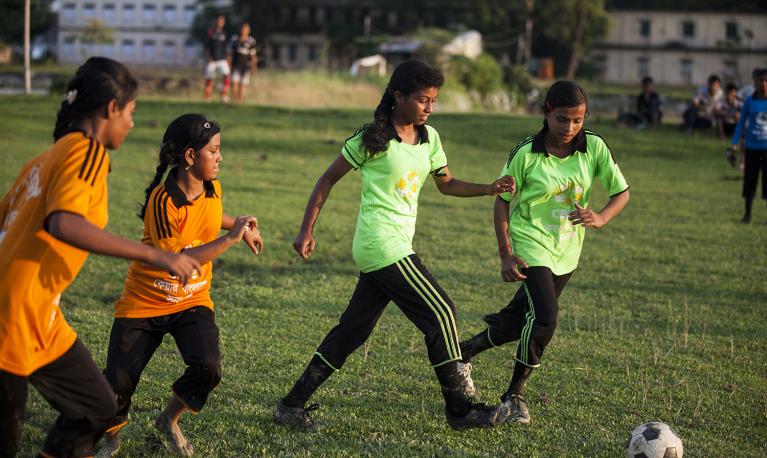
- Project summary
- 16 August 2019
Organisations involved
CARE, Siddhartha Samuyadayik Samaj, Dalit Social Development Center, Jainita Shinnomul Songstha, and Gram Bikash Kendra
Summary
CARE’s Tipping Point initiative focuses on addressing the root causes of child, early and forced marriage (CEFM) and promoting the rights of adolescent girls through community level programming and evidence generation in Nepal and Bangladesh, and multi-level advocacy and cross-learning efforts across the globe.
This three-phase project, during Phase 1 (2013-2017) utilized a feminist and developmental evaluation approach to engage in formative, participatory research. The research informed innovative and iterative learning-driven programming activities; and supported local ideas for programming that included a social norms approach. Additionally, it supported local, national, and global advocacy efforts to broaden the discourse among policy makers, funders, and practitioners on gender transformative approaches to addressing CEFM and measuring progress; and on the need to acknowledge and work on the fear and control of adolescent girls’ sexuality as a core driver of CEFM.
In Phase 2 (2017-2020), the goal is harvesting the evidence and learning from Phase 1, developing and testing programming packages linked to the theory of change (TOC) and these four programming pillar areas: adolescent sexual and reproductive health and rights (ASRHR); access to alternative opportunities for adolescent girls; integration of a social norms approach; and girl-centered movement building. Phase 3 (2020-2023), on the other hand, will utilize the evidence base and critical learning from Phase 2 to systematically institutionalize core programming approaches across CARE’s adolescent girls’ rights and empowerment work and influence policymakers, practitioners, and donors globally.
Social norms of interest
Norms that limit adolescent girls’ mobility and presence in public spaces and limit girls to domestic work, norms around interactions and communication between adolescent girls and boys, norms around girls raising their voice/speaking out, norms around ASRHR, norms around child marriage and norms around dowry.
Project components
The intervention includes community and group activities including:
- girls’ and boys’ groups which have regular meetings in a dedicated safe space with skill building, discussion, life skills curriculum and participating in organizing public events including outdoor team sports for adolescent girls.
- meetings for parents of adolescents in groups with regular meetings and participating in public events.
- Ending Violence Against Women (EVAW) forum or Parents' Groups with home visits, meetings with community gatekeepers and supporting boys and girls in organizing public events.
- connecting to formal and government systems and services with schools re-enrollment and connection to income gathering activities from the government.
- connection to local government advocacy and resource platforms.
Measurement
Photovoice,SenseMaker, and focus group discussions (FGDs)
Behavioural outcomes
- Girls have critical awareness of gender and rights, and strengthen confidence, skills, and social capital for making progressive choices in their lives.
- Social norms related to marriage (dowry expectations, perceptions of girls’ potential, and perceptions of marital relationships that promote hegemonic masculinity and ignore girls’ rights) are changing to be more supportive of girls and against early marriage
- Networks, solidarity groups and organizations collaborate together (laterally and vertically) to take actions for girls
Key findings
The full findings from the Phase 1 evaluation is available through the evaluation reports. Here are highlights of key findings specific to social norms.
Learning: In many contexts social norms are a critical driver of CEFM; however, it is still just one part of the puzzle, so we should not see it as a silver bullet solution and instead see it as a complementary strategy in combination with others. The particular types of social norms driving CEFM vary from context to context, so it is essential to take the time to understand what they are in order to develop targeted activities.
Nepal Evaluation findings on social norms:
- Norms of girls’ behavior loosened under certain conditions
- Tipping Point participants faced some sanctions but were less sensitive to them
- Economic considerations in the marriage process may be shifting
Bangladesh Evaluation findings on social norms:
- Norms loosened under certain conditions
- Girls’ education was increasingly valued
- Tipping Point participants faced sanctions but grew resilient to them
- The process of marriage was little changed
Attribution
CARE grants permission to all not-for-profit organizations engaged in social justice and humanitarian activities to reproduce this work, in whole or in part. The following notice shall appear conspicuously with any reproduction: “Assessing social norms change interventions: CARE’s Tipping Point approach. Copyright © 2018 Cooperative for Assistance and Relief Everywhere, Inc. (CARE). Used by Permission.”
The preferred citation for this tool is: CARE USA. “Assessing social norms change interventions: CARE’s Tipping Point approach.” Cooperative for Assistance and Relief Everywhere, Inc., 2018.
The CARE Tipping Point FGD Tool is adapted from Adapted from CARE’s SNAP Framework, “Applying Theory to Practice: CARE’s Journey Piloting Social Norms Measures for Gender Programming.” Copyright 2017 Cooperative for Assistance and Relief Everywhere, Inc. (CARE). Used by Permission.
The CARE Tipping Point Photovoice tool is adapted from Wang, C., & Burris, M. (1997). Photovoice: concept, methodology, and use for participatory needs assessment. Health Education & Behaviour, 24 (3), 369-387.

Map of social norms-focused projects and measurement approaches
- Tags:
- Voice and agency, Child marriage, Community development, Sexual and reproductive health, Gender-based violence
- Countries / Regions:
- Bangladesh, Nepal
- Data collection methods:
- Focus group
